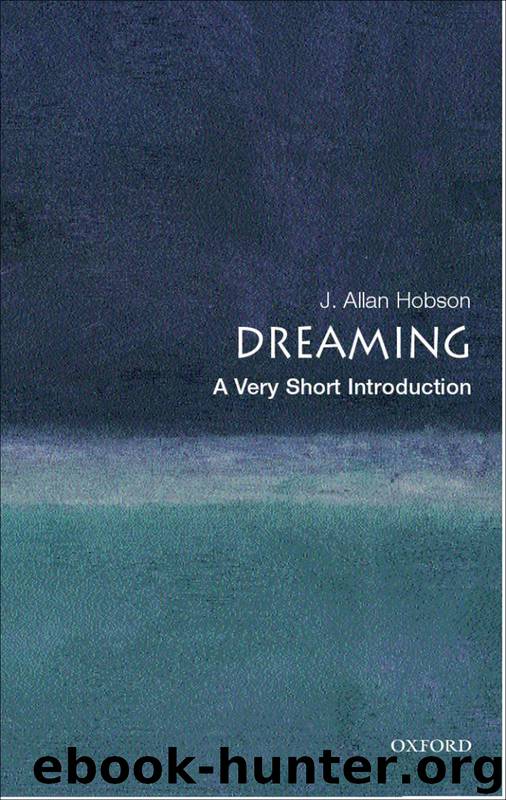Dreaming by Hobson J. Allan;

Author:Hobson, J. Allan; [Hobson, J. Allan;]
Language: eng
Format: epub
ISBN: 0192802151
Publisher: Oxford University Press, UK
Published: 2002-01-15T07:00:00+00:00
Is sleep essential to life?
If we do not survive, we do not reproduce. What do we, as mammals, need to do in order to survive? We need to eat, and to convert dietary calories into fuel for bodily functions; we also need to avoid predation, especially when we are vulnerable – at night, for example. So far, so good. We need to eat without being eaten.
But we must also stay warm (or cool) enough to function effectively. This involves maintaining our core body temperature within the very narrow range of daily fluctuation (no more than 0.83 degrees Celsius, or 1.5 degrees Fahrenheit). If we become overheated, our brains do not work well – in fact they go to sleep, which is why tropical cultures are more likely to create siestas than Thomas Edisons. If we become cold, our brains are equally upset. The mountaineer’s mnemonic for cold exposure says, first you fumble, then you mumble, and then you stumble, and finally, you tumble.
For us, technological kings of the beasts, ‘predation’ may seem like an idle threat. But think of life in the inner city and tell me how much you enjoy walking at night in ill-lit neighbourhoods. Think of the threat of infection against which we must constantly fight to avoid pneumonia (colds and sore throats are bad enough), to avoid invasion of our bloodstreams by the micro-organisms that inhabit our intestines (and normally aid digestion without asking for more than a part of our meals), and to maintain immunity to avoid invasion by a vast army of destructive viruses (such as influenza A, hepatitis B, and so on through the alphabet). These are our predators as much as lions are for zebras!
It turns out that all of these functions suffer when sleep deprivation becomes extreme. The recent experiments of Allan Rechtschaffen and his group, at the same University of Chicago where sleep and dream science began in the early 1950s, made it impossible – or at least very difficult – for one of a pair of rats to sleep. The other rat was free to sleep whenever the sleep-deprived rat was awake. In this way, it was possible to reduce sleep greatly in the one without significant reduction in the other.
It is important to emphasize the fact that these experimental conditions were so extreme that it is difficult to imagine them occurring naturally. It is also important to note that it takes two weeks, a surprisingly long time, for the most severely debilitating effects to set in. Finally, we can take some comfort from the fact that, at any stage in the proceedings, recovery is complete when sleep is allowed. We should not assume, however, that the results of experimental sleep deprivation of a type that we will probably never experience are irrelevant to our own concepts of sleep hygiene. Anyone who has ever noticed that even minor sleep loss leads to increased risk of infection will get this point easily.
The first defect, in what inevitably became a fatal
Download
This site does not store any files on its server. We only index and link to content provided by other sites. Please contact the content providers to delete copyright contents if any and email us, we'll remove relevant links or contents immediately.
Rewire Your Anxious Brain by Catherine M. Pittman(17590)
Talking to Strangers by Malcolm Gladwell(11881)
The Art of Thinking Clearly by Rolf Dobelli(8846)
Mindhunter: Inside the FBI's Elite Serial Crime Unit by John E. Douglas & Mark Olshaker(7836)
Becoming Supernatural by Dr. Joe Dispenza(7108)
Change Your Questions, Change Your Life by Marilee Adams(6645)
Nudge - Improving Decisions about Health, Wealth, and Happiness by Thaler Sunstein(6636)
The Road Less Traveled by M. Scott Peck(6636)
The Lost Art of Listening by Michael P. Nichols(6474)
Enlightenment Now: The Case for Reason, Science, Humanism, and Progress by Steven Pinker(6407)
Win Bigly by Scott Adams(6313)
Mastermind: How to Think Like Sherlock Holmes by Maria Konnikova(6238)
The Way of Zen by Alan W. Watts(5800)
Daring Greatly by Brene Brown(5643)
Grit by Angela Duckworth(4738)
Big Magic: Creative Living Beyond Fear by Elizabeth Gilbert(4726)
Men In Love by Nancy Friday(4328)
Flow by Mihaly Csikszentmihalyi(4055)
The Four Tendencies by Gretchen Rubin(4024)
